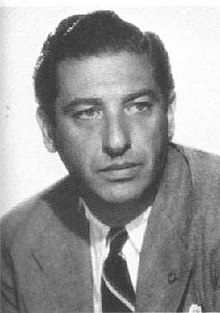Mark Sandrich
Mark Sandrich | |
|---|---|
 | |
| Born | Mark Rex Goldstein October 26, 1900 New York City, U.S. |
| Died | March 4, 1945(aged 44) Los Angeles, California, U.S. |
| Resting place | Home of Peace Cemetery |
| Occupation(s) | Director, producer, screenwriter |
| Years active | 1927–1945 |
| Spouse | Freda W. |
| Children | 2, includingJay |
| Relatives | Ruth Harriet Louise(sister) Carmel Myers(cousin) |
Mark Sandrich(bornMark Rex Goldstein;October 26, 1900 – March 4, 1945) was an American film director, writer, and producer.[1]
Early life[edit]
Sandrich was born in New York City on October 26, 1900[2]into aJewishfamily. His sister wasRuth Harriet Louise.
He was an engineering student atColumbia Universitywhen he accidentally fell into the film business. While visiting a friend on a film set, he saw that the director had a problem setting up a shot; Sandrich offered his advice, and it worked. He entered the movie business in the prop department.[3]
Career[edit]
Shorts director[edit]
Sandrich became a director in 1927, making comedy shorts. His first feature wasRunaway Girls,in 1928. In an exciting time in the film business with the arrival of sound, he briefly returned to shorts. In 1933, he directed theAcademy Award-winning shortSo This Is Harris!.
Feature films[edit]
Sandrich returned to directing features withMelody Cruise(1933). He followed it withCupid in the Rough(1933) and two starring the team ofWheeler & Woolsey,Hips, Hips, Hooray!(1933) andCockeyed Cavaliers(1934).
Astaire and Rogers[edit]
Sandrich did some uncredited second unit work withFlying Down to Rio(1933), a musical featuringFred AstaireandGinger Rogers.In 1934, Sandrich was given the job of directing the first proper Astaire–Rogers musical,The Gay Divorcee,which proved a tremendous success.
The following year, he directedTop Hat(1935), another Fred Astaire and Ginger Rogers musical.[1]He continued working with the team onFollow the Fleet(1936).[4]
After directingKatharine HepburninA Woman Rebels(1936) he returned to Astaire and Rogers forShall We Dance(1937), andCarefree(1938).
Paramount[edit]
In 1939, Sandrich leftRKOforParamount,which offered him a chance to be not only a director, but a producer as well.
Sandrich's first film for Paramount was just as director: theJack BennyvehicleMan About Town(1939).[5]He then turned producer as well as director and made two more with Benny,Buck Benny Rides Again(1940) andLove Thy Neighbor(1940). He also did the romantic comedySkylark(1941), starringClaudette ColbertandRay Milland.
While all of these films made profits for the studio,Holiday Inn(1942), starringFred AstaireandBing Crosby,with music byIrving Berlin,is most remembered today.Holiday Innintroduced the song "White Christmas"performed by Crosby." White Christmas "remains the best-selling single of all time.[6]
Sandrich also produced and directed a dramatic war film,So Proudly We Hail!,a 1943 box-office success that starred Claudette Colbert, Paulette Goddard, and Veronica Lake. It was extremely popular and featured a pair of performers –Adrian Booth(billed as "Lorna Gray" in this picture) andGeorge Reeves– whom Sandrich had intended to bring to stardom after the war.[7]Sandrich's last completed films also were war-related --I Love a Soldier(1944) andHere Come the Waves(1944), both withSonny Tufts.
Personal life and death[edit]
His sons, Mark Sandrich Jr. andJay Sandrich,went on to careers as directors in film and television.
Mark Sandrich supportedThomas Deweyin the1944 United States presidential election.[8]
In 1945, he was in pre-production on a follow-up toHoliday InncalledBlue Skies,starring Bing Crosby and featuring Irving Berlin's music. At the same time, Sandrich was serving as president of theDirectors Guild.
Insisting that he could complete all of his assignments, and feeling pressure to be an involved and loving family man, Sandrich died suddenly of a heart attack at the age of 44.[9]At the time of his death, Sandrich was considered to be one of the most trusted and influential directors in Hollywood. His interment was atHome of Peace Cemetery.
Select credits[edit]
Shorts[edit]
|
Feature films[edit]
|
References[edit]
- ^abSennwald, Andre (August 10, 1935)."Top Hat (1935)".The New York Times.
- ^"Mark Sandrich | American director".Encyclopædia Britannica.RetrievedMay 18,2019.
- ^"Funeral set today for Mark Sandrich"(March 6, 1945).Los Angeles Times
- ^"Young director makes good in musical comedy"(May 1, 1936).The China Press
- ^"Mark Sandrich signs writers"(September 4, 1939).Los Angeles Times
- ^"Producer-director hears critics praise his picture"(July 1, 1942).The Washington Post
- ^By, T. S. (September 12, 1943)."HEROINES WITHOUT MASCARA"The New York Times
- ^Critchlow, Donald T. (October 21, 2013).When Hollywood Was Right: How Movie Stars, Studio Moguls, and Big Business Remade American Politics.ISBN978-1-107-65028-2.
- ^"Mark Sandrich dies suddenly"(March 5, 1945).Los Angeles Times.
External links[edit]
- Mark SandrichatIMDb
- Mark SandrichatFind a Grave
- ObituaryatVariety
